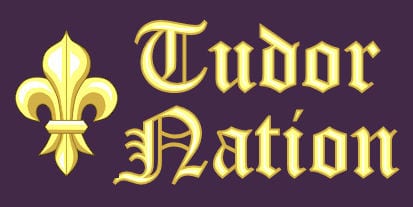The number of people executed by the Tudors is a defining factor when assessing the period. Executions were used to eliminate those who disagreed with policies or attempted to overthrow the new dynasty. Members of the nobility found guilty of treason were executed by beheading, while commoners were hanged (hung), drawn and quartered. Heretics were executed by being burnt at the stake.
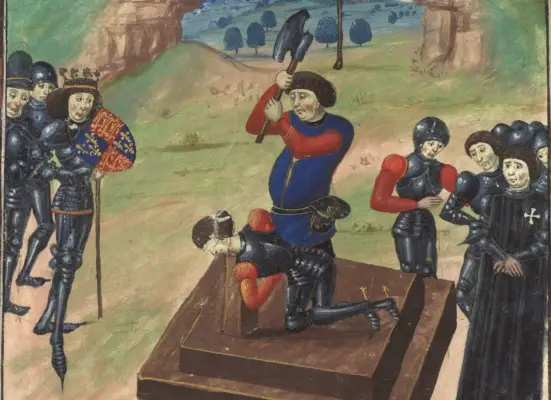
Many executions were held publicly to serve as a warning to the people. Despite this for many people, a public execution was an event not to be missed.
People would queue through the night to get the place with the best view. A handkerchief stained with the blood of a high ranking person could be worth a good sum of money.
Public executions always produced a carnival-like atmosphere with large crowds and a good trade was done by pie sellers, ale merchants and producers of execution memorabilia. Peddlers, minstrels, jugglers and other street performers also took advantage of this ready-made audience.
In total, around 80,000 people were executed by the Tudors and nearly 60,000 of that number were executed during the reign of King Henry VIII.
Notable people executed by the Tudors
1485
25th August
William Catesby
William Catesby was a Chancellor to King Richard III. He was executed three days after the Battle of Bosworth Field.
1486
8th July
Sir Humphrey Stafford
Stafford was a Yorkist who had fought in the Wars of the Roses. He attempted to overthrow King Henry VII but was caught and executed for treason at Tyburn.
1494
28th April
Joan Boughton
Joan Boughton was an elderly widow who supported the ideas of the religious reformer John Wycliffe. She was executed by being burnt at the stake.
1495
16th February
William Stanley
Stanley was the younger brother of Thomas Stanley, Earl of Derby, Henry VII’s step-father. He was executed by beheading for supporting the pretender to the throne, Perkin Warbeck.
1497
27th June
Michael An Gof aka Michael Joseph
Thomas Flamank
James Tuchet, Baron Audley
For leading the Cornish Rebellion against taxes imposed by Henry VII, An Gof and Flamank were hanged, drawn and quartered at Tyburn, while James Tuchet was executed by beheading.
1499
12th February
Ralph Wulford
Executed for claiming to be Edward, Earl of Warwick, nephew of King Edward IV.
23rd November
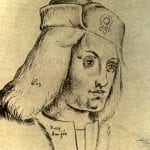
Perkin Warbeck
Warbeck had posed a real threat to Henry VII, claiming to be Richard Duke of York, younger son of King Edward IV. Although Warbeck had gained much support he had been defeated and imprisoned in the Tower of London. After conspiring with Edward Earl of Warwick (also a prisoner in the Tower) to take the throne he was hanged at Tyburn.
28th November
Edward, Earl of Warwick
Edward was the nephew of King Edward IV and had been imprisoned because he was a claimant to the throne and a threat to Henry VII. After conspiring with Perkin Warbeck he was executed by beheading on Tower Hill.
1502
6th May
Sir James Tyrrell
James Tyrrell was arrested for supporting Edmund de la Pole, a Yorkist claimant to the throne. It is alleged that he also confessed to the murder of the Princes in the Tower. He was executed by beheading.
1510
17th August
Sir Richard Empson
Edmund Dudley
Empson and Dudley were chief ministers of Henry VII who had been disliked for raising taxes. When Henry VIII became King they were charged with constructive treason (a crime that was felt to be tantamount to treason). They were executed by beheading on Tower Hill.
1513
30th April
Edmund de la Pole, Duke of Suffolk
Edmund was a Yorkist who had exiled himself to France. He was captured in 1502, stripped of his title and imprisoned in the Tower of London. He was executed by beheading before Henry VIII left England to invade France.
1521
17th May
Edward Stafford Duke of Buckingham
Stafford, a former Yorkist, was loyal to King Henry VIII and fought with him in France. In 1521 he was found guilty of listening to prophecies of the King’s death and determining to kill the King. He was executed by beheading on Tower Hill.
1534
20th April
Elizabeth Barton aka The Nun of Kent
Elizabeth Barton was a Catholic nun who, in 1532, began publicly prophesying that King Henry VIII would die and go to hell if he married Anne Boleyn. She was arrested in 1533 and charged with treason for conspiring to bring down the King. She was hanged at Tyburn along with her chief supporters, Edward Bocking, a Benedictine monk and Richard Risby, a Franciscan friar.
1535
4th May
John Houghton
Robert Lawrence
Augustine Webster
They were all Carthusian monks at the London Charterhouse who were executed by being hanged, drawn and quartered for refusing to swear the Oath of Succession.
19th June
Humphrey Middlemore
William Exmew
Sebastian Newdigate
These men were Carthusian monks at the London Charterhouse. They were executed by being hanged, drawn and quartered for refusing to swear the Oath of Succession.
22nd June
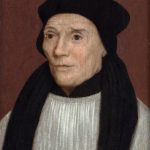 John Fisher Bishop of Rochester
John Fisher Bishop of Rochester
Bishop Fisher was executed by beheading for refusing to swear the Oath of Succession.
6th July
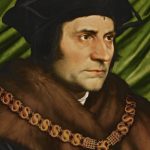 Sir Thomas More
Sir Thomas More
Thomas More had been appointed Chancellor of England after the fall of Thomas Wolsey. As a committed Catholic he refused the Oath of Succession and was beheaded at Tower Hill.
1536
17th May
George Boleyn Viscount Rochford
Henry Norris
William Brereton
Francis Weston
Mark Smeaton
George Boleyn was the brother of Anne Boleyn, Norris was King Henry VIII’s Groom of the Stool, Brereton and Weston served as Grooms of the King’s Privy Chamber and Smeaton was a court musician. They were all charged with treason for committing adultery with Anne Boleyn. Smeaton was executed by being hanged, drawn and quartered while the other men were beheaded.
19th May
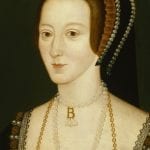
Anne Boleyn
Anne Boleyn was the second wife of Henry VIII. Having failed to give Henry a son, she was tried, and found guilty of committing adultery with Henry Norris, William Brereton, Francis Weston, Mark Smeaton and her brother George Boleyn. She was beheaded by a swordsman who had been summoned from Calais on Tower Green.
1537
30th June
Thomas Darcy
Darcy was one of the leaders of the Pilgrimage of Grace (rebellion against the closure of the monasteries). He was found guilty of treason and executed by beheading on Tower Hill.
6th July
Sir Robert Constable
Constable was one of the leaders of the Pilgrimage of Grace. He was sent north and exhibited as a traitor along the way before being executed by hanging in Hull.
12th July
Robert Aske
Robert Aske was the acknowledged leader of the Pilgrimage of Grace (rebellion against the closure of the monasteries). He was captured and sent to the Tower of London. He was then taken north and hanged in chains from Clifford’s Tower in York Castle and left to die.
1538
9th December
Henry Courtenay, Marquess of Exeter
Courtenay was a cousin of Henry VIII. He was sent by the King to put down the Pilgrimage of Grace but failed in his mission. Thomas Cromwell saw Courtenay as a rival and managed to convince Henry VIII that he was in league with Cardinal Reginald Pole. He was executed by beheading by sword on Tower Hill.
1539
9th January
Henry Pole
Despite being loyal to King Henry VIII, Henry Pole was charged with treason for supporting his brother Cardinal Reginald Pole. He was found guilty and executed by beheading on Tower Hill.
3rd March
Nicholas Carew
Carew was a member of the king’s household and a diplomat. In 1538 he was angered by a comment made by the King. Thomas Cromwell used this to persuade Henry VIII that Carew was involved in a plot to remove him and put Reginald Pole on the throne. Carew was found guilty and executed by beheading on Tower Hill.
1540
28th July
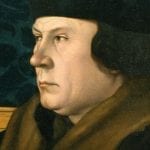
Thomas Cromwell Earl of Essex
Cromwell rose to become Lord Chancellor after suggesting the English Reformation to help Henry VIII secure a divorce from Catherine of Aragon. He later engineered the downfall of Anne Boleyn. He fell from favour after arranging Henry VIII’s marriage to Anne of Cleves. He was charged with treason and found guilty without a trial. He was executed by beheading on Tower Hill.
30th July
Thomas Abel
Richard Featherstone
Edward Powell
Abel and Featherstone had been chaplains to Catherine of Aragon while Powell was a court preacher. All three opposed the King’s divorce and refused to take the Oath of Succession. They were initially imprisoned but and were now executed by being hanged, drawn and quartered at Smithfield.
1541
27th May
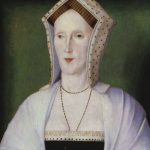 Margaret Pole Countess of Salisbury
Margaret Pole Countess of Salisbury
Margaret Pole was the niece of King Edward IV. Her son, Reginald had entered the church and strongly opposed the English Reformation. The Pope created him a Cardinal and asked him to support the Pilgrimage of Grace. Margaret had been imprisoned by Henry VIII and she was now executed by beheading on Tower Hill.
1541
10th December
Francis Dereham
Thomas Culpeper
Dereham had a relationship with Kathryn Howard before she became queen and served as her Private Secretary. Culpeper was a courtier and one of the King’s close circle. Both men were found guilty of committing adultery with the queen and executed at Tyburn. Dereham was hanged, drawn and quartered while Culpeper was beheaded..
1542
13th February)
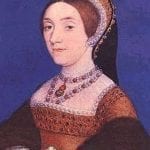 Kathryn Howard
Kathryn Howard
Jane Boleyn
Kathryn was lady-in-waiting to Anne of Cleves before becoming the fifth wife of King Henry VIII. She was found guilty of committing adultery with Thomas Culpeper and Francis Dereham. Her lady-in-waiting, Jane Boleyn was found guilty of helping the Queen to commit adultery. Both women were executed by beheading on Tower Green.
1546
16th July
Anne Askew
Askew was a Protestant who was accused of heresy and imprisoned in the Tower of London. She was tortured but refused to recant or reveal names of other Protestants. She was executed by burning at Smithfield.
1547
19th January
Henry Howard Earl of Surrey
Howard was the son of Thomas Duke of Norfolk. He was a courtier and cousin to Anne Boleyn and Kathryn Howard. Henry VIII believed that Howard wanted to take the throne for himself. He was accused of treason and executed by beheading.
1549
20th March
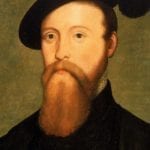
Thomas Seymour
Thomas Seymour was the younger brother of Jane Seymour and uncle of King Edward VI. He had married Katherine Parr but after she died, he tried to bring his brother down and take power himself. He was found guilty of treason and executed by beheading.
1549
7th December
Robert Kett
William Kett
Robert Kett and his brother William were leaders of a rebellion against the hardships caused by enclosure of common land and the policies of Edward Seymour. They were found guilty of treason and executed by hanging at Norwich.
1552
22nd January
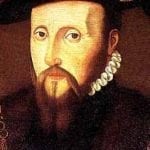
Edward Seymour Duke of Somerset
Edward Seymour was the brother of Jane Seymour, third wife of King Henry VIII, and the uncle of King Edward VI. He ruled as Lord Protector because Edward was a minor but his decision to enclose common land led to revolts against his rule. This was used by the council to accuse Seymour of mismanagement and he was removed from his post. He was arrested after plotting to overthrow his successor, John Dudley and executed by beheading.
1553
22nd August
John Dudley Duke of Northumberland
Dudley had taken over as Protector of England after the fall of Edward Seymour. He married his son, Guildford, to Jane Grey, granddaughter of Henry VIII’s sister, Mary. When Edward was on his deathbed it was decided that Protestant Lady Jane Grey should be Queen rather than Catholic Mary. The people rose for Mary and Jane Grey was overthrown after just 9 days. John Dudley was found guilty of treason and executed by beheading.
1554
12th February
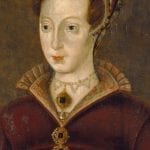 Lady Jane Grey
Lady Jane Grey
Guildford dudley
Jane Grey was the granddaughter of King Henry VIII’s sister, Mary. She was forcibly married to John Dudley’s son, Guildford and chosen to be Queen by Edward VI and the Council because she was Protestant. However, the people rose for Henry VIII’s daughter Mary. Mary had Jane and Guildford imprisoned but after Jane’s father joined a rebellion led by Thomas Wyatt against Queen Mary. Mary ordered their execution by beheading.
1554
23rd February
Henry Grey Duke of Suffolk
Henry Grey was the father of Lady Jane Grey. He had supported the move to make her Queen because she was Protestant. However, the people rose for Henry VIII’s daughter Mary. Early in 1554, Henry Grey joined a rebellion led by Thomas Wyatt against Queen Mary. He was captured and executed by beheading.
11th April
Thomas Wyatt the Younger
Thomas Wyatt the younger was the son of the poet, Thomas Wyatt. In January 1554 he organised a revolt against the marriage of Queen Mary I to Philip of Spain. The revolt was suppressed, Wyatt was captured and found guilty of treason. He was executed by beheading.
1555
4th February
John Rogers
Rogers was a Protestant clergyman who had helped to translate the Bible into English. Mary I was determined to restore England to Catholicism and passed legislation that allowed the burning of Protestant heretics. Rogers was the first to be executed by burning under this new legislation.
6th October
Nicholas Ridley
Nicholas Ridley was Protestant Bishop of London. He was charged under the new legislation introduced by Queen Mary I against Protestants. Ridley was executed by burning in Oxford.
16th October
Hugh Latimer
Hugh Latimer was Protestant Bishop of Worcester. He was convicted of heresy and executed by burning in Oxford.
1556
21st March
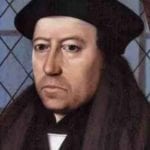
Thomas Cranmer
Thomas Cranmer was Protestant Archbishop of Canterbury who had been a leader of the English Reformation under King Henry VIII. Under King Edward VI he had helped to introduce the Book of Common Prayer. He fell from favour during the reign of Queen Mary I because he was a Protestant and was executed by burning in Oxford.
1572
2nd June
Thomas Howard Duke of Norfolk
Howard was the son of Henry Howard who had been executed in January 1547. He was the grandson of Thomas Howard, Duke of Norfolk and inherited the title when his grandfather died. Howard was implicated in the Ridolfi Plot which sought to depose Elizabeth and put Mary Queen of Scots on the English throne. He was found guilty of treason and executed by beheading on Tower Hill.
22nd August
Thomas Percy Earl of Northumberland
Thomas Percy was a Catholic and head of the Percy family of Northumberland. He led a northern uprising to depose Queen Elizabeth and replace her with Mary Queen of Scots. He was captured, found guilty of treason and executed by beheading at York.
1584
10th July
Sir Francis Throckmorton
Francis Throckmorton was the leader of a plot to depose Queen Elizabeth I and replace her with Catholic Mary Queen of Scots. He confessed the conspiracy after being tortured. He was executed by beheading.
1586
25th March
Margaret Clitherow
Margaret Clitherow was a Roman Catholic who helped to shelter Catholic priests and also allowed mass to be held in her home. She was arrested but refused to enter a plea of guilty or not guilty which meant she could not be tried. In order to exact a plea she was laid on on the floor, covered with the door to her house and then heavy rocks were placed on top until she died.
20th September
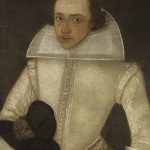 Sir Anthony Babington
Sir Anthony Babington
Anthony Babington was a Catholic nobleman who helped transport letters to Mary Queen of Scots. He hatched a plot to assassinate Queen Elizabeth and put Mary Queen of Scots on the throne. The plot was discovered and Babington was arrested and tried. He was executed by being hanged, drawn and quartered.
1587
8th February
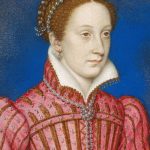 Mary Queen of Scots
Mary Queen of Scots
Mary Queen of Scots was the daughter of King James V of Scotland. She had become Queen of Scotland at just six days old but had been raised in France for her safety. She married Francis of France then returned to Scotland after he died. She fell from favour after her husband was killed following an explosion and she was implicated in the murder. After being forced to abdicate in favour of her son, James VI she fled to England. Queen Elizabeth I kept her under house arrest but after plots to depose Elizabeth and put Mary on the throne she was executed by beheading.
1601
25th February
Robert Devereux Earl of Essex aged 36 years
Devereux was a nobleman and had been a favourite of Queen Elizabeth I. He fell from favour after failing to restore order in Ireland and becoming overly familiar with the Queen. He was charged with treason after a failed coup, found guilty and executed by beheading.
18th March
Sir Christopher Blount
Sir Charles Danvers
Both men were supporters of Robert Devereux and took part in his failed coup. They were charged with treason, found guilty and executed by beheading.
Published Nov 16, 2021 @ 6:39 pm – Updated –
Harvard Reference for this page:
Heather Y Wheeler. (2021). How Many People Were Executed by the Tudors? Available: https://www.tudornation.com/how-many-people-were-executed-by-the-tudors Last accessed [date]
